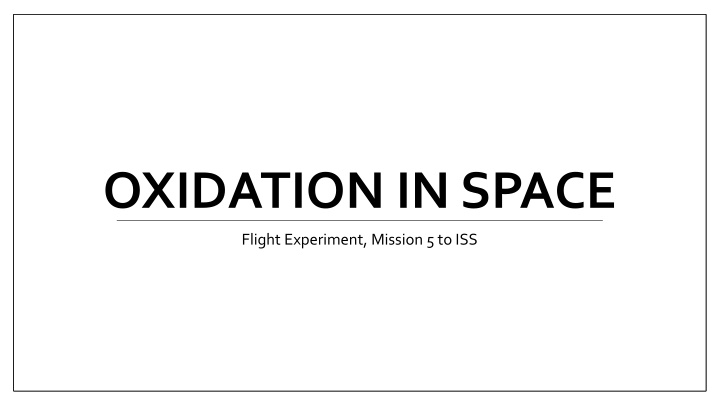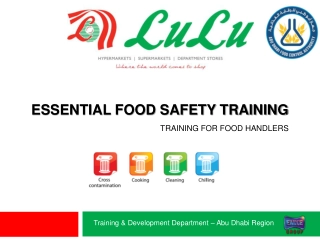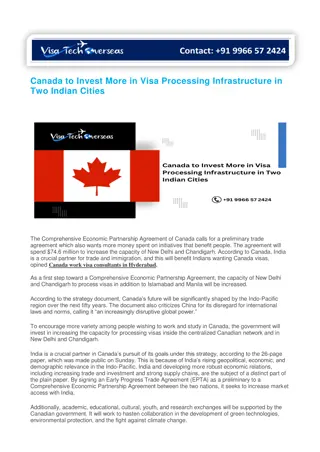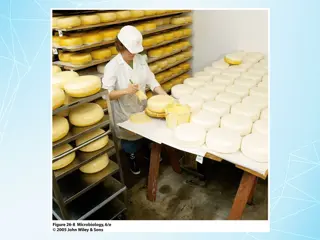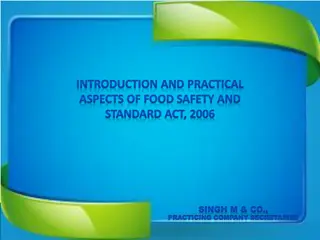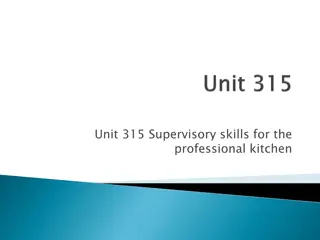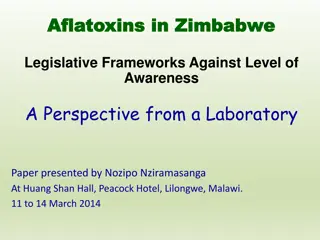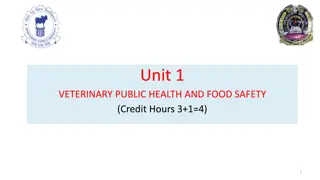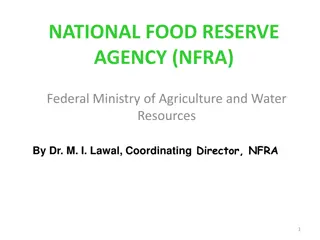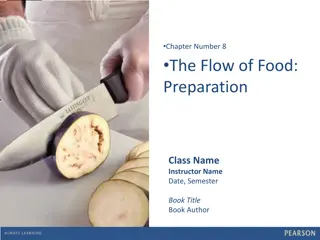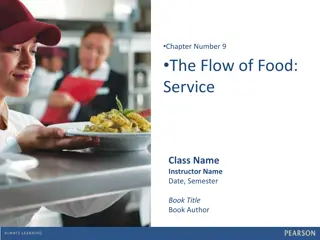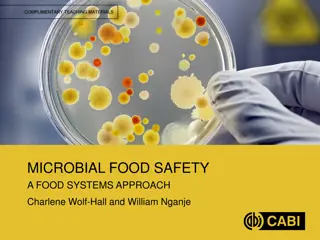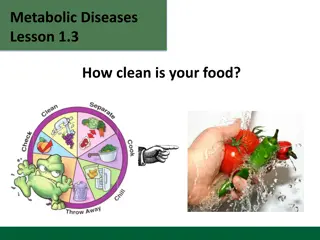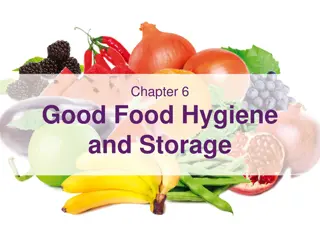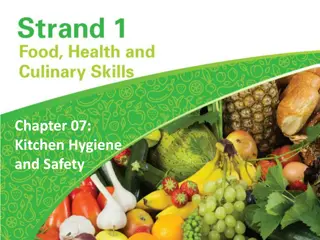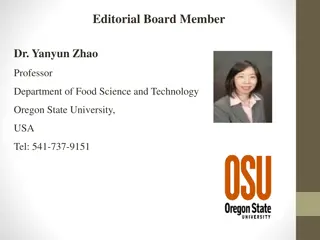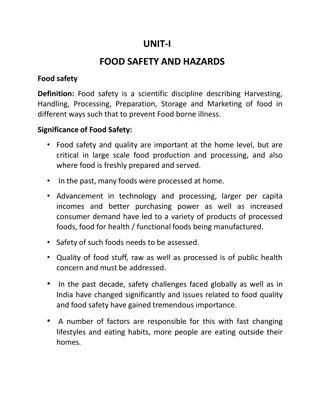Food Safety Regulations in Canada
Food safety regulations in Canada, including Health Canada policies and regulations under the Safe Food for Canadians Act. Learn about Listeria species, pathogens, growth conditions, and infective doses. Test your knowledge on foodborne pathogens and their impact. Discover key information about Listeria monocytogenes, its growth requirements, and associated risks.
Download Presentation

Please find below an Image/Link to download the presentation.
The content on the website is provided AS IS for your information and personal use only. It may not be sold, licensed, or shared on other websites without obtaining consent from the author.If you encounter any issues during the download, it is possible that the publisher has removed the file from their server.
You are allowed to download the files provided on this website for personal or commercial use, subject to the condition that they are used lawfully. All files are the property of their respective owners.
The content on the website is provided AS IS for your information and personal use only. It may not be sold, licensed, or shared on other websites without obtaining consent from the author.
E N D
Presentation Transcript
OXIDATION IN SPACE Flight Experiment, Mission 5 to ISS
TEAM DEFYING MICROGRAVITY TEAM DEFYING MICROGRAVITY Teacher Facilitator: Team: Defying Microgravity Robert J. Jacobsen Grade Level of Student Team: Eighth Grade Position: SSEP Coordinator and Seventh and Eighth Grade Science Teacher School: St. Peter s School Address: 6400 Charlotte, Kansas City, MO 64131 School District: Kansas City -St. Joseph s Diocese Email: bjacobsen@stpeterskc.org Co-Principal Investigators: Tone NaeBradley-Toomer Zoe Butler Anna Campbell Maureen Egan
ABSTRACT ABSTRACT The four scientists would like to determine the effect of microgravity upon the process of oxidation. This experiment is being observed because in a spacecraft, including the International Space Station (ISS), there is the presence of free floating water that could damage (via oxidation or corrosion) the metal of the interior and/or exterior of that spacecraft. The oxidation of an iron nail will be studied as water is added to its section of the Fluid Mixing Enclosure (FME Mini-Lab). The young scientists are looking to determine if oxidation (or corrosion) occurs faster, slower, or at all because of microgravity.
HYPOTHESIS HYPOTHESIS The researchers believe that the 2-penny steel finishing nail will rust at a slower rate in an environment of microgravity than on Earth. The researchers believe that in a microgravity environment, the water will not be drawn as easily to the nail and adhere to it. On Earth, since the gravitational pull is much stronger, the attraction of water molecules to the nail should be stronger. Therefore, the rate and amount of oxidation (corrosion) on Earth should be greater than in a microgravity environment.
EXPERIMENT MATERIALS AND EXPERIMENT MATERIALS AND HANDLING REQUIREMENTS HANDLING REQUIREMENTS Fluids Mixing Enclosure (FME) Type to be Used: Volume 1: Type 2 FME (Two Experiment Volumes: One Clamp Used) One Steel Nail (2-Penny Finishing) List of Proposed Experiment Samples (Fluids and Solids to be Used): pH: Solid sample does not require a pH rating Water (5 ml) Volume 2: One Steel Nail (2-Penny Finishing) Water (5 ml) Type 2 FME: pH: 6.5 7.0 Proposed Experiment Timeline of Crew Interactions Aboard ISS: A=0: Unclamp the clamp
THE QUESTION TO BE THE QUESTION TO BE ADDRESSED BY THE EXPERIMENT ADDRESSED BY THE EXPERIMENT What is the effect of microgravity upon the process of oxidation? The scientists would like to determine if microgravity affectsthe oxidation process. In other words, does the oxidation process occur faster or slower in a microgravity environment? Oxidation is the process in which a substance is combined with oxygen. Corrosion is the process in which metal, stone, or other material chemically breaks down. The external components of aircrafts and spacecraftsare sprayed with oil to prevent corrosion. However, there may be free-floating water in the interior of a spacecraft and/or space station. For example, if the astronauts were to spill water while drinking or were to perspire excessively, an accumulation of moisture could occur within the spacecraft or space station. Steel is one of the various metals found in space crafts and space station that is prone to oxidation. This experiment may help determine if there is a need to protect the metal of the spacecraft from corrosion (rusting). The researchers believe that the 2-penny steel finishing nail will rust at a slower rate in an environment of microgravity than on Earth. The researchers believe that in a microgravity environment, the water will not be drawn as easily to the nail and adhere to it. On Earth, since the gravitational pull is much stronger, the attraction of water molecules to the nail should be stronger. Therefore, the rate and amount of oxidation (corrosion) on Earth should be greater than in a microgravity environment. The young scientists have been researching microgravity, and the effects of it. There have been experiments conducted similar to theone that the researchers are conducting. The Module Seven of CCE 281 Corrosion studied the impacts, principals, and practical solutions of corrosion. The Iron Corrosion Products studied the corrosion of different colored iron nails. The young researchers will gain from this project the knowledge of the effect of microgravity upon the process of oxidation. They will learn if oxidation occurs at a greater rate in space than on Earth. They will gain this knowledge by observing the experiment on Earth (This will serve as the control of the experiment.) at the same time as it is being conducted in the ISS (International Space Station).
EXPERIMENT DESIGN EXPERIMENT DESIGN The Experimental Rationale: The effect of microgravity upon the oxidation process of a nail will be studied. duration of the astronauts stay in the ISS. The FME will be left unclamped throughout the entire The Experimental Materials: The researchers will be using water Earth, at the same time, as the ground truth (control). The same procedure will be conducted with a nail on because it is a common substance that causes oxidation (rusting) to Ground Elements: While the experiment is conducted by the astronauts occur. They will be testing a 2-penny steel finishing nail because it will in space, the four young scientists will conduct the same experiment on fit in the FME and it commonly rusts. The researchers will blunt Earth. They will unclasp the clasp separating the water from the nail the 2-penny steel finishing nail that will be sent to the ISS as well as and observe the oxidation process over period of time. the nail on Earth (to serve as the control or ground truth). The 2-penny Experimental Analysis: The analysis will be prepared by measuring the mass of the nail before it goes to space and after it comes back to Earth The mass of the nail will be determined using an electronic scale. The nail will also be observed under a microscope, before and after the experiment is conducted. The analysis will provide data showing if the nail gained rust under the effects of microgravity. The analysis will be conducted by the researchers. A blind test will be conducted by the researchers when the project is returned to Earth. finishing nail will be made of steel, and will not be composed of any protective coatings. The Experimental Procedure: same day that they arrive to the ISS. First, the astronauts will unclamp the single clamp on the
ACKNOWLEDGEMENTS ACKNOWLEDGEMENTS Team Defying Microgravity of Mission 5 would like to thank the following organizations and partnerships for allowing their dreams to come true: Benjamin BannakerCharter Academy of Technology aSTEAMVillage Alliance Academie Lafayette Alta Vista Charter Middle School Della Lamb Elementary Charter School Hogan Preparatory Academy Middle School St Peter s School Distribution by Air Google Fiber Ewing Marion Kauffman Foundation KC STEM Alliance
